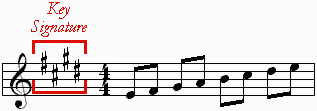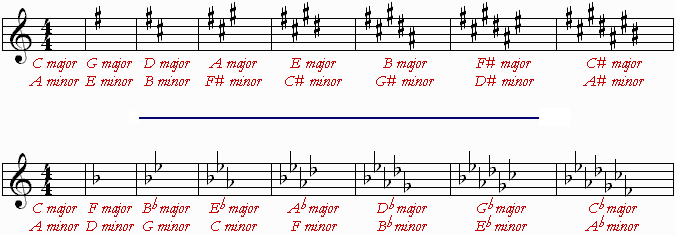
Key Signatures
Key signatures tell you what key you are playing in (go figure...).
Understanding key signatures is extremely easy but extremely important for understanding
standard musical notation. In order for you to understand this discussion,
a knowledge of the note names is necessary. Good luck
with this, and if you have any questions please
e-mail me!
An example key signature is shown below:

Notice how there are four sharps included in the key signature: F#, C#, G#, and D#.
This means we are in the key of E (so the E major scale
is shown on the staff). If you are confused about this, check out my
chord theory page or my
guitar scales page. Flats can also appear in
a key signature, as will be shown below. However, flats and
sharps never appear in the same key signature.
When a sharp (or flat) appears in the key signature, it means that any time you play that note,
no matter what octave you play it in, you play it sharped (or flatted). So in the above
example you always play F#, C#, G#, and D#. The only exception is when a natural
sign ( ) appears in front of a note.
In that case, you play the note at the normal pitch instead of
sharped or flatted.
) appears in front of a note.
In that case, you play the note at the normal pitch instead of
sharped or flatted.
Every single key signature appears in the image below, along with its corresponding
major and minor keys:

To learn what chords you can play in each of these keys, check out my
guitar chord theory page.
Back to Dansm's Musical Notation for Guitar
You are visitor number
 since 6-22-97
since 6-22-97
© 1997 Daniel E. Smith. Last updated 6-22-97


 ) appears in front of a note.
In that case, you play the note at the normal pitch instead of
sharped or flatted.
) appears in front of a note.
In that case, you play the note at the normal pitch instead of
sharped or flatted.